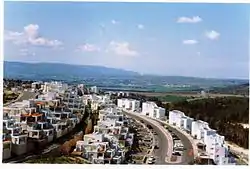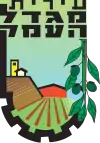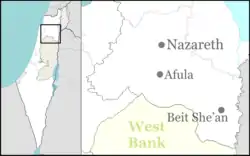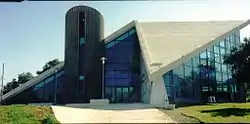Migdal HaEmek
Migdal HaEmek (Hebrew: מִגְדַּל הָעֶמֶק, lit. Tower of the Valley, also officially spelt Migdal HaEmeq, Arabic: مجدال هعيمق) is a city in the Northern District of Israel. It was founded in 1953 on the remnants of the Palestinian village of Al-Mujaydil, following the 1948 depopulation of Palestine.
Migdal HaEmek
| |
|---|---|
| Hebrew transcription(s) | |
| • ISO 259 | Migdal ha ʕemq |
| • Also spelled | Migdal HaEmeq (official) |
 | |
 | |
 Migdal HaEmek  Migdal HaEmek | |
| Coordinates: 32°40′17″N 35°14′26″E | |
| Country | |
| District | Northern |
| Founded | 1953 |
| Government | |
| • Mayor | Eliyahu Barda |
| Area | |
| • Total | 7,637 dunams (7.637 km2 or 2.949 sq mi) |
| Population (2019)[1] | |
| • Total | 25,675 |
| • Density | 3,400/km2 (8,700/sq mi) |
| Name meaning | Tower of the Valley |
In 2019 it had a population of 25,675.[1] There is a tower to the north-east, above the town.
History
Background and establishment

Prior to 1953, the area nearest to where Migdal HaEmek was founded was an Arab Palestinian village named al-Mujaydil. It had existed there since as early as 1596 during the Ottoman era.[2][3][4]
In July 1948, the village which Migdal HaEmek replaced, al-Mujaydil, was "completely destroyed"[5] due to aerial bombing[6] during the operations conducted by Yishuv Golani Brigade forces, resulting in its depopulation, before Israel established its independence.[7]
Migdal HaEmek was started in 1953 as a ma'abara for Jews from Arab countries, before becoming a development town. The original site of the ma'abara was west of the current site, at Shimron hill.
In 1959, during Wadi Salib riots, the "Union des Nords-africains led by David Ben Haroush, organised a large-scale procession walking towards the nice suburbs of Haifa creating little damages but a great fear within the population. This small incident was taken as an occasion to express the social malaise of the different Oriental communities in Israel and riots spread quickly to other parts of the country; mostly in towns with a high percentage of the population having North African extraction like in Tiberias, in Beer-Sheva, in Migdal HaEmek[8]".
The chief rabbi of the city is Rabbi Yitzchak Dovid Grossman, who won the Israel Prize in 2004 for his social service work and outreach youth programs. Every year volunteers from Habonim Dror come to Migdal HaEmek to volunteer in the community. Typically these roles include members of Kvutsat Yovel, and involve teaching in primary and secondary schools, and working with local Magen David Adom units.
Demographics
According to CBS, in 2001 the ethnic makeup of the city was all Jewish and "other" non-Arabs. There were 11,900 males and 12,200 females. More recently the Jewish Agency estimated Migdal HaEmek's population at 28,000, almost half foreign-born, from Russia, the Caucasus, Ethiopia, Morocco, Iraq and South America.
Education
According to CBS, there were 22 schools and 5,777 students in the city in 2001: 13 elementary schools (2,995 students), and 2 high schools (2,782 students). 47.8% of 12th grade students qualified for a matriculation certificate in 2001.
Economy
Many Israeli and global high tech companies are located in three industrial parks. Among the companies: Tower Semiconductor (foundry), RSL Electronics (Control and Diagnostic solutions for defence and commercial applications ), KLA-Tencor (inspection tools), CI Systems (electro-optical test systems, non contact temperature sensors and wet chemistry analyzers), Nilit (Nylon for textile industry and thermoplastics for industrial and commercial applications), Vishay Intertechnology (discrete and passive semiconductors components), Enzymotec (functional lipids) and Flex (Electronics contract manufacturer).
Notable residents
- Haim Dayan, politician
References
- "Population in the Localities 2019" (XLS). Israel Central Bureau of Statistics. Retrieved 16 August 2020.
- Hütteroth and Abdulfattah, 1977, p. 187
- Note that Rhode, 1979, p. 6 writes that the register that Hütteroth and Abdulfattah studied was not from 1595/6, but from 1548/9.
- Khalidi, Walid (1992). All That Remains: The Palestinian Villages Occupied and Depopulated by Israel in 1948. Washington D.C.: Institute for Palestine Studies. ISBN 0-88728-224-5. Khalidi (1992), p.350
- Masalha, Nur (2003). The politics of denial: Israel and the Palestinian refugee problem. The University of Michigan: Pluto Press. ISBN 0745321208.
- Institute, For Defence Studies and Analyses (1987). News Review on West Asia, Volume 18. The University of Virginia: Institute for Defence Studies and Analyses. ISBN 0745321208.
- Morris, Benny (2004). The Birth of the Palestinian Refugee Problem Revisited. Cambridge University Press. ISBN 978-0-521-00967-6.
- Jeremy Allouche, The Oriental Communities in Israel, 1948-2003, , p.35
.svg.png.webp)